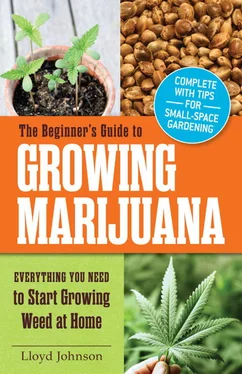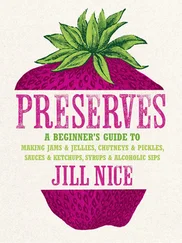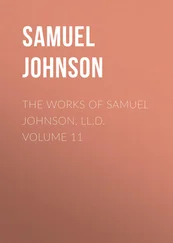An indoor grower may access soil or compost they have outside, but the outdoor grower has to consider whether to plant young plants directly into the ground or in large containers. There are good reasons for both alternatives. Containers protect plant roots from burrowing rodents and allow the grower to control exactly what soil the plant has access to. Growing in the ground allows cannabis to show its ability to get extremely large. Ground-planted cannabis is able to spread out its roots and grow.
If you plan to grow your plants in the ground in existing soil, you will need to identify your soil type so that you can amend it for optimum cannabis production. The main types of soil are as follows:
Clay
Clay soil is typically composed of 60 percent clay, 20 percent silt, and 20 percent sand. The clay actually has quite a few nutrients for the plant but is a very fine particle that tends to compact, interfering with the oxygen supply that plant roots require to actually use the nutrients. This compaction also makes the soil like concrete, allowing water to run off the surface so it cannot get to your plants’ roots.
Obviously, clay soil is a poor choice for growing almost anything, let alone cannabis. If you plan to plant in the ground, you must dig out the offending clay and replace with your own amended soil mix. The bigger the hole, the better, but two to three feet in diameter and three feet deep will accommodate an outdoor plant quite well.
Adobe
Adobe is the mother of all clay soils; dig it out and replace, or, rather than struggle with iron-hard adobe, accept that you will be using containers and adjust your growing plans. You can try to amend adobe soil, but it will take years and truckloads of compost materials.
Sandy
Sandy soil can be very difficult to correct; it is on the other end of the spectrum from clay, as it drains too well and the plant loses the nutrients as water carries them away. It is also very wasteful of water and makes it difficult to know how much water the plants are actually receiving. A typical sandy soil will be almost 70 percent sand. If you have sandy soil, start amending it immediately with organic materials, but plan on growing your cannabis in containers for the first few years. It takes a lot of work to adjust sandy soils, although with time, lots of organic material, and patience, it can be improved.
Loam
Loam is the Holy Grail of soils. It retains nutrients and water easily accessed by the plants and is very easy to work with. Most growers do not wake up one morning and have loam, but good organic gardening practices can improve a reasonable soil until it becomes loam. Loam is made up of 40 percent sand, 40 percent silt, and 20 percent clay. In this mix, the plant can access the good nutrients in clay soil because there is sufficient air available. When you are mixing your own soil, strive to match the blend that makes loam so special for plants.
Alternative Mediums for Growing
The so-called “soilless” or artificial soil mixes are inexpensive and sterile growing mediums used by commercial growers, particularly the hydroponics folks. Generally, artificial soils are made from perlite, vermiculite, peat moss, sand, and other components like coconut coir and pumice. Since the artificial soil is just a medium, if you plan to use it, be aware that you will have to supply all the nutrients the plants will need.
Perlite and Vermiculite
Perlite and vermiculite are both widely used in the horticultural industry because they are sterile and free from diseases, provide aeration and drainage, have a fairly neutral pH, are both nontoxic, and are relatively inexpensive. Indoor growers use them extensively, and outdoor growers frequently use them to lighten a soil mix.
Peat Moss
Peat moss is formerly living sphagnum moss from bogs that has partially decomposed. As a soil amendment, peat moss breaks down too fast, compressing the soil and creating an unhealthy lack of air for plant roots. It can be useful when lightened with perlite, but the mining of peat moss is an environmentally unsound practice.
Scraping off the top layer of living sphagnum moss affects the habitat for many rare plants, insects, and birds. For this reason, the cannabis grower who is also a friend to the environment should consider the implications of using peat moss. If you must use this artificial soil, be aware that peat moss is quite acidic; check the pH level by testing the runoff water and adjust as needed.
Plant roots need air to access food as well as water. A dense, compacted soil like clay may have lots of nutrients, but they remain unavailable to the plant due to lack of air. Good aeration stimulates beneficial bacterial activity, allowing the plant to use more organic matter.
Compacted soil will also speed up moisture loss: In packed soils, water rises very rapidly to the surface and is lost through evaporation. This can get frustrating, especially when you are paying a large water bill.
Minerals are also essential for healthy growth in cannabis. Most chemical fertilizers only focus on measuring levels of nitrogen, phosphorus, potassium, and calcium; these primary elements are essential, but used in excess can result in deficiencies in other elements your plants will need.
Cannabis prefers a soil that is not too acidic and not too alkaline; a pH of 6.5 is just about perfect. Some growers swear by a slightly lower pH; most estimate that the range for soil-grown cannabis is 6.5 to 7.5.
Acidic soil will lock up nutrients, making them unavailable to your plant for growth and flowering. Highly acidic soil also damages the soil balance by limiting the growth of beneficial soil organisms. This is why you do not plant your cannabis in pure compost; too high of an organic content can raise the acid level to the point where your plant cannot use the nutrients you provide. Highly alkaline soil can lead to salt accumulation and limit the roots’ ability to take up water.
The soil for your cannabis should be organic and alive. Cannabis is a consumable, like a vegetable, that you will put into your body. If you use organic, live soil, you will see greatly improved plant health and also notice an increase in the quality of your end product.
Living soil organisms decompose organic compounds, sequester nitrogen and other nutrients, and fix nitrogen from the atmosphere, making it available to the plants. Soil organisms also prey on crop pests. Soil organisms interact with one another, with plants, and with the soil. The combined result is a number of beneficial functions, including nutrient cycling, moderated water flow, and pest control.
Soil organic matter is used for the energy and nutrients the plants need. Bacteria, fungi, and other soil dwellers transform and release nutrients for the plants to use. In living soil, the soil directly around plant roots is teeming with bacteria. These bacteria feed on sloughed-off plant cells and the proteins and sugars released by roots. The protozoa and beneficial nematodes that eat the bacteria are also concentrated near roots. Complex organic compounds, called humus , remain after the many soil organisms have used and transformed the original material. Humus is important for improving water- and nutrient-holding capacities.
This nutrient cycling and disease suppression is very complex and very much needed by your plants. It is far better to work with nature and encourage natural controls than to dump in chemical fertilizers that will eventually destroy your soil.
Читать дальше












